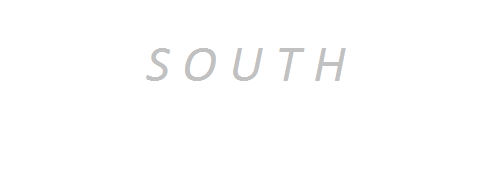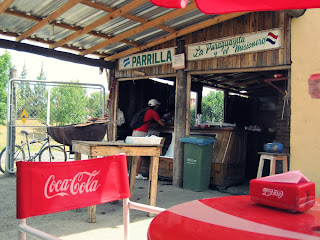I had planned my route the night before and in the morning I packed my gear and prepared to leave the hostel at Tigre. Instead of heading further north to San Antonio de Areco I had decided to head southwest to Luján. From there I would be another day's ride from Ruta 3 which would take me to the end of the world.
The hostel owner asked me how I was riding to Luján and I told him. No, I could not ride that way, he said. It was too dangerous. I would ride through neighborhoods of robbers and thieves. He told me to wait and went across the street to talk to a friend and came back with him. The friend told me a safer way, but it would include riding on the Acceso Oeste Auto Pista. I would also need to ride on 2 other large highways before reaching the Acceso Oeste. I did not like riding on major highways but it was a better alternative to being robbed and beaten.
I rode out of Tigre and onto the first highway. There was only a tiny shoulder and it was hot in the late morning, the sky cloudless, the sun hot, and trucks and cars barreled past me. I concentrated on the line of the shoulder and rode ahead. On this highway I was bypassing the dangerous barrio and the hostel owner told me under no condition was I to get off the highway until I reached the exit before the toll booth.
At the toll booth (peaje) I exited the highway onto a smaller, tree-lined road that wound south to the auto pista. I was still congested from my sickness and could not hear out of my left ear and had hoped to ride leisurely, but riding on an auto pista in the heat of the day, where bicycles are prohibited, camions and buses bombing past you on a small shoulder covered in trash and dirt and broken glass, cannot ever be leisurely riding.
I rode up to a van of workers escorting 2 large tractors slowly down the road and tucked in behind the van with the flashing arrow directing traffic to the other lane. Following this van I was able to stay off the shoulder and I could relax a little. It was almost comfortable to ride an auto pista in this way and safter to ride in a convoy, but then I hit a huge bump in the pavement and my left rear pannier jumped off my rear rack, dragging behind my wheel on the road. As I slowed to stop the pannier unhooked from the rack and skidded into the middle of the lane. I put the bike down and ran back and pulled the pannier out of the road before a truck hit it. The pannier contained my sleeping bag and tools and it had almost been a disaster.
At Moreno I stopped and had a chorizo sandwich for lunch. It was brutally hot and I felt exhausted and the flies swarmed me as I ate. There was still another 30 kms to Luján. A man at the roadside restaurant gave me dirty water that flowed through a hose from a gas pump and swore to me it was potable. I was too thirsty not to drink it.
But then the shoulder (banquina) ended. It would be too dangerous to continue and I got off the Acceso Oeste and rode south through Moreno to Ruta 7, a two lane road that ran parrallel to the auto pista. The sun was now directly overhead and the wind blowing in my face, grabbing at my panniers, and it was hot and dusty riding without a shoulder on Ruta 7, but the traffic was slower and lighter than on the auto pista and it felt safer. It was a dirty area and like much of the urban sprawl of Buenos Aires it did not seem very safe.
I was gutted when I made Luján after 5pm and rode towards the center of town and the basilica. It was the most famous basilica in Argentina and pilgrims came from across the country to see it. The hostel I hoped to stay at was located just in front of it in the long, stone-paved square that faced the basilica.
Sharing the dorm room with me was Diego. He was a serious young man who had married and had a child with an older woman. He commuted 4 hours per day by bus to his IT job in Buenos Aires and was continually exhuasted. Every few months he would take a weekend trip alone, away from his family, to gather himself and this was one of those weekend trips. Diego worked in computer programming and wanted to start his own business but felt he could not take such a risk as the primary provider for his family. He was a bright but troubled young man who was trying to decide whether to pursue his dream and felt its burden and we got on well and I liked him.
Diego and I went to dinner together not far from the hostel but I was nearly falling asleep at the table. I did not have the energy to eat. I looked at myself in the bathroom mirror and my eyes were bloodshot and hollow. The auto pistas had severely reduced me. With my sun darkened arms and legs and face, and the gone look in my eyes, I reminded myself of that somewhat famous photography of Eddy Merckxx, shirtless in his riding shorts leaning his head back against the wall of the locker room, looking distant and far away, having ridden and lost the Paris-Robaix.
Over a dinner of Milanesas Napolitanas Diego told me much about Argentina and I learned from him about the extensive taxes that severely limit economic activity in the country. Earning more than the equivalent of $1,000/month would trigger luxury taxes. Property prices were also severely inflated and unless an Argentine had inherited a house through his parents that he could sell for cash to buy a new one, it was not possible to save enough to purchase a home. Taxes had also made cars and electronics unaffordable for most people. Much of the country existed only for the already wealthy.
It would be a difficult environment to start up a business but I encouraged Diego to try. To have lived his life without trying would result in a deep regret. I told him to have tried and failed was better than to never have tried. Our talk energized him and he wanted to talk more but I needed to sleep.






0 comments:
Post a Comment